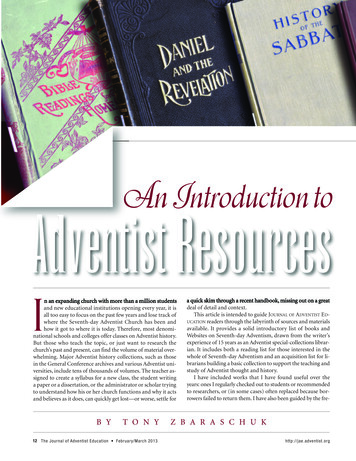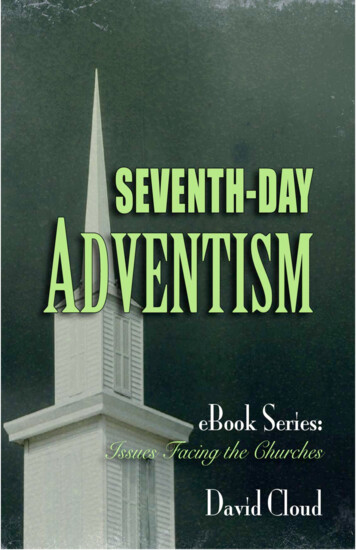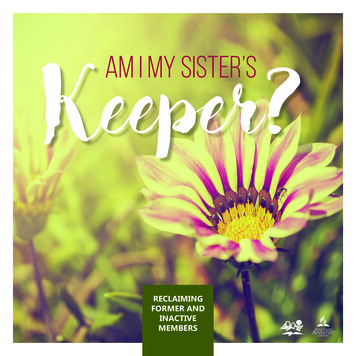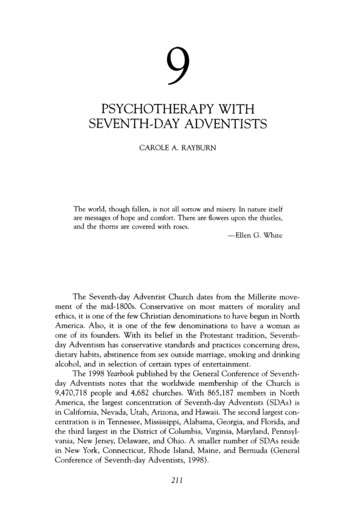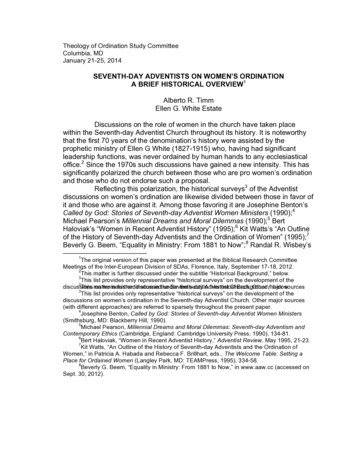
Transcription
Theology of Ordination Study CommitteeColumbia, MDJanuary 21-25, 2014SEVENTH-DAY ADVENTISTS ON WOMEN’S ORDINATIONA BRIEF HISTORICAL OVERVIEW1Alberto R. TimmEllen G. White EstateDiscussions on the role of women in the church have taken placewithin the Seventh-day Adventist Church throughout its history. It is noteworthythat the first 70 years of the denomination’s history were assisted by theprophetic ministry of Ellen G White (1827-1915) who, having had significantleadership functions, was never ordained by human hands to any ecclesiasticaloffice.2 Since the 1970s such discussions have gained a new intensity. This hassignificantly polarized the church between those who are pro women’s ordinationand those who do not endorse such a proposal.Reflecting this polarization, the historical surveys3 of the Adventistdiscussions on women’s ordination are likewise divided between those in favor ofit and those who are against it. Among those favoring it are Josephine Benton’sCalled by God: Stories of Seventh-day Adventist Women Ministers (1990);4Michael Pearson’s Millennial Dreams and Moral Dilemmas (1990);5 BertHaloviak’s “Women in Recent Adventist History” (1995);6 Kit Watts’s “An Outlineof the History of Seventh-day Adventists and the Ordination of Women” (1995);7Beverly G. Beem, “Equality in Ministry: From 1881 to Now”;8 Randal R. Wisbey’s1The original version of this paper was presented at the Biblical Research CommitteeMeetings of the Inter-European Division of SDAs, Florence, Italy, September 17-18, 2012.2This matter is further discussed under the subtitle “Historical Background,” below.3This list provides only representative “historical surveys” on the development of the2discussionsThis matteron women’sis furtherordinationdiscussedin theunderSeventh-daythe �Other majorbelow.sources3This list provides only representative “historical surveys” on the development of thediscussions on women’s ordination in the Seventh-day Adventist Church. Other major sources(with different approaches) are referred to sparsely throughout the present paper.4Josephine Benton, Called by God: Stories of Seventh-day Adventist Women Ministers(Smithsburg, MD: Blackberry Hill, 1990).5Michael Pearson, Millennial Dreams and Moral Dilemmas: Seventh-day Adventism andContemporary Ethics (Cambridge, England: Cambridge University Press, 1990), 134-81.6Bert Haloviak, “Women in Recent Adventist History,” Adventist Review, May 1995, 21-23.7Kit Watts, “An Outline of the History of Seventh-day Adventists and the Ordination ofWomen,” in Patricia A. Habada and Rebecca F. Brillhart, eds., The Welcome Table: Setting aPlace for Ordained Women (Langley Park, MD: TEAMPress, 1995), 334-58.8Beverly G. Beem, “Equality in Ministry: From 1881 to Now,” in www.aaw.cc (accessed onSept. 30, 2012).
2“SDA Women in Ministry, 1970-1998” (1998);9 and Gary Patterson’s “Analysis ofWhat Is Happening with the Ordination of Women Pastors” (2012).10Historical surveys against women’s ordination include C. MervynMaxwell’s “A Very Surprising (and Interesting) History” (1998);11 SamuelKorangteng-Pipim’s “Misleading and Erroneous Claims Regarding EarlyAdventist History” (2001);12 Heber N. de Lima’s “Women’s Ordination in theSeventh-day Adventist Church: Brief Historical Overview” (2003);13 and WellesleyMuir’s Daughters of Inheritance: A New Look at Women’s Ordination (2010).14More neutral historical overviews appear in Richard W. Schwarz andFloyd Greenleaf’s Light Bearers: A History of the Seventh-day Adventist Church(2000);15 and David Trim’s paper “The Ordination of Women in Seventh-dayAdventist Policy and Practice, up to 1972” (2013).16Additional insights on the overall discussion are provided by Ján Barnain his Ph.D. dissertation, “Ordination of Women in Seventh-day AdventistTheology: A Biblical and Theological Analysis and Synthesis of the Debate withSpecial Attention to Hermeneutical Matters” (2009).17 For a sociological criticalperspective of this debate, see Laura L. Vance’s Seventh-day Adventism inCrisis: Gender and Sectarian Change in an Emerging Religion (1999);18 andMalcolm Bull and Keith Lockhart’s Seeking a Sanctuary: Seventh-day Adventismand the American Dream (rev. 2007).199Randal R. Wisbey, “SDA Women in Ministry, 1970-1998,” in Nancy Vyhmeister, ed.,Women in Ministry: Biblical & Historical Perspectives (Berrien Springs, MI: Andrews UniversityPress, 1998), 235-55.10Gary Patterson, “Analysis of What Is Happening with the Ordination of Women Pastors”(2012), in www.atoday.org (accessed on August 16, 2012).11C. Mervyn Maxwell, “A Very Surprising (and Interesting) History,” Adventists Affirm(October 1998), 18-22; republished in Mercedes H. Dyer, ed., Prove All Things: A Response toWomen in Ministry (Berrien Springs, MI: Adventists Affirm, 2000), 225-30.12Samuel Koranteng-Pipim, Must We Be Silent? Issues Dividing Our Church (Ann Arbor,MI: Berean Books, 2001), 251-70.13H. Nicholas de Lima, “Women’s Ordination in the Seventh-day Adventist Church: BriefHistorical Overview” (B.Th. thesis, Brazil Adventist University College, 2003), 4-15.14Wellesley Muir, Daughters of inheritance: A New Look at Women’s Ordination (Roseville,CA: Amazing Facts, 2010), 103-43.15Richard W. Schwarz and Floyd Greenleaf, Light Bearers: A History of the Seventh-dayndAdventist Church, 2 ed., rev. (Nampa, ID: Pacific Press, 2000), 464-70.16David Trim, “The Ordination of Women in Seventh-day Adventist Policy and Practice, upto 1972” (Paper presented to the Theology of Ordination Study Committee, Linthicum Heights,Maryland, July 2013).17Ján Barna, “Ordination of Women in Seventh-day Adventist Theology: A Biblical andTheological Analysis and Synthesis of the Debate with Special Attention to HermeneuticalMatters” (Ph.D. thesis, University of Bristol, 2009). A slightly revised version of this thesis waspublished under the title, Ordination of Women in Seventh-day Adventist Theology: A Study inBiblical Interpretations (Belgrade, Serbia: Preporod, 2012).18Laura L. Vance, Seventh-day Adventism in Crisis: Gender and Sectarian Change in anEmerging Religion (Urbana and Chicago: University of Illinois Press, 1999), 172-229.19Malcolm Bull and Keith Lockhart, Seeking a Sanctuary: Seventh-day Adventism and thendAmerican Dream, 2 ed. (Bloomington and Indianapolis, IN: Indiana University Press, 2007),259-72.
3The present paper provides a brief historical overview of the Seventhday Adventist discussions on women’s ordination. The subject is arranged underthe following subheadings: (1) Historical Background; (2) Camp MohavenMeetings (1973); (3) Washington, DC, Meetings (1985); (4) Cohutta SpringsMeetings (1989); (5) Utrecht General Conference Session (1995); (6) FurtherDiscussions (1996-2010); and (7) New Directions (2010-2014). Special emphasisis placed on official church documents, with only sporadic allusions to thecontributions made by individuals and groups representing the differentsegments of the discussion.Historical BackgroundNineteenth-century Adventist theological discussions usually favoredwomen’s participation in church activities that would not require ordination.Commenting on the expression “let your women keep silence in the church” (1Cor. 14:34), Uriah Smith wrote in 1866 that in this text Paul is not forbiddingwomen to pray or prophesy in public (cf. 1 Cor. 11:5), for the Bible mentionsseveral women who were prophetesses (Judges 4:4-9; 2 Kings 22:14-20; Luke2:36-38; Acts 21:8, 9) and leaders in local congregations (Rom. 16:3-16; Phil.4:2, 3). Based on his understanding of the male headship established at thecreation and fall of Adam and Eve (Gen. 3:16: 1 Cor. 11:8; 1 Tim. 2:13, 14),Smith argued that “this order is not to be reversed, and the woman take theposition which has been assigned to the man; and every action on her part whichshows that she is usurping this authority, is disorderly, and not to be allowed.”20In 1878, in the Signs of the Times, J. H. Waggoner published an articleon “Woman’s Place in the Gospel” declaring that, according to Paul, women canlabor for the Lord by prophesying, edifying, exhorting, and comforting. But theyare not allowed to perform “all the duties of business meetings, which wereprobably conducted by men, or all the duties of ruling elders, and pastors” (cf. 1Tim 2:12; 5:17).21 Following in the same line, “The S. D. A. Church Manual”(1883)22 favored the notion of women functioning as unordained deaconesses,because “it has not . . . been the custom with us to ordain such women.”23In 1895 Milton C. Wilcox answered the question “Should women beelected to offices in the church when there are enough brethren?” He argued that“If by this is meant the office of elder, we should say at once, No”; because “wedo not believe that it is in God’s plan to give to women the ordained offices to the20[Uriah Smith], “‘Let Your Women Keep Silence in the Churches,’” Adventist Review, andSabbath Herald, June 26, 1866, 28.21[J. H. Waggoner], “Woman’s Place in the Gospel,” The Signs of the Times, Dec. 19, 1878,380 (italics in the original).22See [W. H. Littlejohn], “The S. D. A. Church Manual,” 18-part series in Advent Review andSabbath Herald, June 5, 1883, 361-62; June 12, 1883, 377-78; June 19, 1883, 393-94; June 26,1883, 409; July 3, 1883, 426-27; July 10, 1883, 441-42; July 17, 1883, 457-58; July 24, 1883, 474;July 31, 1883, 491; Aug. 7, 1883, 505-6; Aug. 14, 1883, 521-22; Aug. 21, 1883, 537-38; Aug. 28,1883, 553-54; Sept. 4, 1883, 569-70; Sept. 11, 1883, 586-87; Sept. 18, 1883, 602-3; Sept. 25,1883, 618; Oct. 9, 1883, 631-32.23Ibid., July 3, 1883, 426-27.
4church.” On the other hand, he admitted that there are offices that women canhold, such as church clerk, treasurer, librarian of the tract society, anddeaconess.24Undoubtedly, women played a crucial role in the formation anddevelopment of the church. Between 1878 and 1915 there were, in addition toEllen White, 30 other Adventist women “licensed to preach.”25 Brian E. Strayerstates that “California Conference president J. N. Loughborough regularlyordained female elders and deacons. In the 1890s, while in Australia and NewZealand, W. C. White also ordained female deacons.”26 On numerous occasionsWhite preached her sermons in the presence of ordained pastors, including theGeneral Conference President. Apparently, people did not question her right as afemale to use the pulpit to communicate God’s word.From the early 1870s onward the leadership of the church grantedEllen White ministerial credentials, some of which retained the expression“ordained minister.”27 In 1884, when the first SDA Yearbook was published, hername was listed among the “Ministers” (not Licentiates), and the same continuedto be the case in the following Yearbooks and GC Bulletins.28 But, according tothe White Estate staff, “she was never ordained by human hands, nor did sheever perform a wedding, organize a church, or conduct a baptism.”29The first significant Adventist administrative discussion on the matter ofwomen’s ordination surfaced at the 1881 General Conference Session, BattleCreek, Michigan. The Fifth Meeting (December 5) of the Session, with S. N.Haskell as chair and Uriah Smith as secretary, considered the followingresolution,Resolved, That females possessing the necessary qualifications to fill that position,may, with perfect propriety, be set apart by ordination to the work of the Christian ministry.This was discussed by J. O. Corliss, A. C. Bourdeau, E. R. Jones, D. H. Lamson, W.H. Littlejohn, A. S. Hutchins, D. M. Canright, and J. N. Loughborough, and referred to the30General Conference Committee.The Signs of the Times of January 5, 1882, transcribed “among theresolutions adopted” at that General Conference only the first paragraph of thisreport, leaving the second one completely out.31 So the readers of the Signs24[Milton C. Wilcox], “No. 176. Who Should Be Church Officers?” The Signs of the Times,Jan. 24, 1895, 3.25See “Women Licensed as Ministers, 1878-1975,” Spectrum 16/3 (Aug. 1985): 60;.Though the published list contains 31 names during that time period, “Hetty Haskell” (1900) and“Mrs. S. N. Haskell” (1902) are the same person. So the actual number of women is 30.26Brian E. Strayer, “Adventist Roots” (letter), Adventist Review, Oct. 11, 2012, 4.27See White Estate staff, “Exhibits Relating to the Ordination of Women: From the Lifetimeand Experience of Ellen G. White” (Paper presented at the Ministerial Meeting at the 1990General Conference Session), White Estate.28See Ellen G. White Estate, “Records Pertaining to Ellen G. White’s Ministerial/OrdinationCredentials,” in www.whiteestate.org (released in Oct. 2012) (see Appendix 1).29White Estate staff, “Exhibits Relating to the Ordination of Women.”30Uriah Smith, sec., “General Conference,” Advent Review and Sabbath Herald, Dec. 20,1881, 392.31“General Conference,” Signs of the Times, Jan. 5, 1882, 8.
5were not informed that the proposal, instead of being approved, was “referred tothe General Conference Committee.” But the original minutes for the 1881General Conference, kept in the General Conference Archives, read exactly as inthe Review.32Ellen White did not attend the 1881 General Conference Session. Herhusband had died on August 6, and two weeks later she left for California. Inaddition to being absent from the meeting that discussed the issue of women’sordination, she also did not express herself about it. Some have understood hersilence as an endorsement on the matter, and others, as disapproving it.Whatever the position one takes, the argument of silence is not conclusive andcan lead to dangerous distortions. The fact of the matter is that the proposal was“referred to the General Conference Committee” (without any of the endorsingwords such as “Adopted” or “Carried”), and it “was not heard of again.”33Unquestionably, Ellen G. White encouraged women to join men in thegospel ministry. Speaking of husband and wife being united in the work, shestated that “there are women who should labor in the gospel ministry. In manyrespects they would do more good than the ministers who neglect to visit theflock of God.”34 In a testimony on “The Canvasser as a Gospel Worker, sheadded, “It is the accompaniment of the Holy Spirit of God that prepares workers,both men and women, to become pastors to the flock of God.”35 But she did notdirectly address the issue of women’s ordination, except perhaps in the followingparagraph from her article “The Duty of the Minister and the People,” published inthe Review of July 9, 1895:Women who are willing to consecrate some of their time to the service of the Lordshould be appointed to visit the sick, look after the young, and minister to the necessities ofthe poor. They should be set apart to this work by prayer and laying on of hands. In somecases they will need to counsel with the church officers or the minister; but if they aredevoted women, maintaining a vital connection with God, they will be a power for good in36the church. This is another means of strengthening and building up the church.Despite all the discussions around this statement, we should keep inmind that the women referred to (1) were not to be full-time workers, becausethey would consecrate only “some of their time to the service of the Lord”; (2) thefunction they would carry on would be more of a deaconess than of a pastor, forthey would commit themselves “to visit the sick, look after the young, andminister to the necessities of the poor”; and (3) they were “to counsel with thechurch officers or the minister,” thus indicating that Ellen White did not considerthis “laying on of hands” to be the same as that of a minister or a church officer.32Minutes of the 1881 General Conference, in Records of the General Conference ofSeventh-day Adventists, Vol. 2, Commencing Nov. 7, 1879, p. 61, GC Archives.33Schwarz and Greenleaf, Light Bearers, 131-32.34Ellen G. White, “The Laborer Is Worthy of His Hire,“ Ms 43a, 1898; published in idem,Evangelism (Hagerstown, MD: Review and Herald, 2002), 472.35Ellen G. White, Testimonies for the Church (Boise, ID: Pacific Press, 1948), 6:322.36E. G. White, “The Duty of the Minister and the People,” The Advent Review and SabbathHerald, July 9, 1895, 434.
6Speaking of her own call to the prophetic ministry, Ellen White wrote in1911, “In the city of Portland the Lord ordained me as his messenger, and heremy first labors were given to the cause of present truth.”37 But this statementdoes not imply that she was ordained as a pastor by the laying on of hands. In aletter of June 16, 1916, to Mrs. L. E. Cox from San Antonio, Texas, ClarenceCrisler, one of Ellen White’s leading secretaries, explained that he had “neverseen from her pen any statement that would seem to encourage the formal andofficial ordination of women to the gospel ministry.”38To what extent Crislerunderstood or captured the basis of Ellen White’s concerns is not known, but thisstatement at least provides his testimony that she did not offer encouragementfor women to be ordained.Yet, neither the pro-women’s ordination proposal (which was notadopted at the 1881 General Conference Session) nor Ellen White’s 1895statement raised much interest on the matter of women’s ordination at that timeand even in the following decades. In 1950, the General Conference Officers’Meeting minutes recorded, “In California some women have been ordained forDorcas Society work. Agreed, To list this item on agenda for Home and ForeignOfficers.39 As an unusual kind of ordination, this incident should not beconsidered an ordination to the gospel ministry.Up to the late 1960s, there were only sporadic and sparse allusions towomen’s ordination. But several factors contributed to making Adventists moreinterested in the topic. From a socio-political perspective, the American CivilRights Act of 1964, with emphasis on “Equal Employment Opportunity,”40 helpedmore women to be employed by the denomination, and later would be referred toas requiring women to be ordained to the gospel ministry. From the financialside, there was unequal pay between men and women, and American ordainedministers usually can pay lower taxes than non-ordained church workers, whichmay have stimulated some people (including women) to seek ordainedministerial status.41 From a pastoral perspective, in 1968 the Northern EuropeanDivision forwarded a request from the Finland Union (which during World War IIplaced some women into pastoral positions) to ordain women to the gospelministry; but that request was not followed up.42In 1972 Josephine Benton was ordained at the Brotherhood Church inWashington, DC, by the presidents of the Potomac Conference and theColumbia Union Conference, thereby becoming the first Adventist female local37Ellen G. White, “An Appeal to Our Churches throughout the United States,” Review andHerald, May 18, 1911, 3; also in idem, Daughters of God (Hagerstown, MD: Review and Herald,2005), 252.38C. C. Crisler to Mrs. L. E. Cox, June 16, 1916, E G White Estate. See also Appendix C –“Exhibits Relating to the Ordination of Women,” in E. G. White, Daughters of God, 248-55.39“Ordination of Women,” [General Conference] Officers’ Meeting, May 3, 1950, GCArchives.40See “Transcript of Civil Rights Act (1964),” Title VII, in www.ourdocuments.gov (accessedon Aug. 23, 2012).41Maxwell, “A Very Surprising (and Interesting) History,” Adventists Affirm (Oct. 1998), 1822.42Bert Haloviak, “The long road to Mohaven,” The Adventist Woman, Sept.-Oct. 1993, 1.
7elder. In 1973 Benton became an associate pastor at the Sligo Church. Otherwomen were soon ordained as local elders at the Walla Walla College Churchand the Green Lake Church in Seattle, Washington State.43 These incidentsconvinced the leadership of the church that a more in-depth study on the role ofwomen in the church was needed.Camp Mohaven Meetings (1973)Adventist more in depth discussions on women’s ordination to thegospel ministry began with the Council on the Role of Women in the Seventh-dayAdventist Church, convened in Camp Mohaven, Danville, Ohio, September 1619, 1973. Under the sponsorship of the General Conference, the councilgathered together a group of 14 women (including Josephine Benton, MadelynnJones Haldeman, Hedwig Jemison, Leona G. Running, and Kit Watts) and 13men (including C. E. Bradford, Raoul Dederen, Gerhard F. Hasel, Frank B.Holbrook, Gordon Hyde, C. Mervyn Maxwell, and Ed Zinke). The committee waschaired by a General Conference Vice-President, W. J. Hackett, with GordonHyde (from Biblical Research Institute) as Secretary.Out of the discussions a document emerged suggesting, for instance,that (1) “the equality of all believers was established by creation and is beingrestored through redemption in Jesus Christ”; (2) there is “no significanttheological objection to the ordination of women to Church ministries”; (3) “a pilotprogram for women in pastoral and evangelistic roles” should be established inreceptive fields “on a two-year basis, with the expectation of renewal uponevaluation”; and (4) an interim report of the pilot program should be presented forthe 1974 Annual Council, as “a basis for any recommendations concerning theordination of women to the gospel ministry which would require consideration bythe 1975 General Conference session.”44The Camp Mohaven document was submitted to and evaluated by the1973 Autumn Council (on October 18), which decided that (1) the report andrecommendations of the Council on the Role of Women, and selected paperspresented to it, “be made available to the divisions of the General Conference forstudy of this subject at the division level”; (2) “the divisions giving study to thesubject share their findings and recommendations with the President’s ExecutiveAdvisory if possible in time for consideration at the Annual Council of 1974”; and(3) “the emphasis of the report upon the priesthood of all believers and thenecessity of involving the total resources of the Church for the rapid completionof the gospel commission be accepted.”45In line with these suggestions, on October 17 the 1974 Annual Councilvoted at the same time (1) to reaffirm the emphasis on the priesthood of all43Beem, “Equality in Ministry: From 1881 to Now,” in www.aaw.cc.“The original Camp Mohaven document,” The Adventist Woman, Sept.-Oct. 1993, 6.451973 Autumn Council of the General Conference Committee (Washington, DC, October7-18, 25, 1973)—General Actions ([Washington, DC]: General Conference of SDAs, 1973), 1920; “Actions of General Interest from the 1973 Annual Council—2,” Advent Review and SabbathHerald, Dec. 6, 1973, 19.44
8believers for the rapid completion of the gospel commission; and (2) to deny theordination of women to the gospel ministry. It was argued thatbecause the Seventh-day Adventist Church is a world church which includes in itsfellowship peoples of all nations and cultures, and because a survey of its world divisionsreveals that the time is not ripe nor opportune, therefore, in the interest of the world unity ofthe church, no move be made in the direction of ordaining women to the gospel ministry.But it was requested that the President’s Executive Advisory should “arrange fora continuing study of the theological and practical implications of the ordination ofwomen to the gospel ministry.”46Consequently, several articles and books on women’s ordinationappeared in print. For example, in 1976 La Vonne Neff’s 2-part series “TheOrdination of Women” considered the experience of some North Americandenominations who did not ordain females to the gospel ministry and others whodid so.47 Realizing that eventually the Seventh-day Adventist Church would haveto decide where to stand on this matter, Neff warned that such decision shouldnot be made “apart from an adequate understanding of God’s Word.”48 In his 4part series “Jesus and the Status of Women,”49 Walter F. Specht concluded thatwomen were treated by Jesus “in every sense as on the same level with men.”“Although He did not designate women as apostles, He did accept a group ofGalilean women as followers.”50In the same year (1976), John G. Beach’s book, Notable Women ofSpirit: The Historical Role of Women in the Seventh-day Adventist Churchobserved that by that time women had already served the denomination “asteachers, treasurers, evangelists, writers and editors, General Conferencedepartmental leaders,” and “have held every administrative position exceptpresident and ordained minister.”51A significant step toward an Adventist theology of ordination was takenby Ministry magazine in its February 1978 issue. That issue carried an article byT. H. Blincoe titled, “Needed—A Theology of Ordination”,52 and a helpful 16-pageinsert entitled, “A Theology of Ordination: A Seventh-day AdventistInterpretation”, with contributions by Gordon M. Hyde (“Introduction”), RaoulDederen (“Nature of the Church” and “A Theology of Ordination”), and Gottfried461974 Annual Council of the General Conference Committee (Loma Linda, California,October 9-17, 1974)—General Actions ([Washington, DC]: General Conference of SDAs, 1974),12-14.47La Vonne Neff, “The Ordination of Women,” 2-part series in Advent Review and SabbathHerald, Aug. 5, 1976, 1, 6, 7; Aug. 12, 1976, 6-8.48Ibid., Aug. 12, 1976, 8.49Walter F. Specht, “Jesus and the Status of Women,” 4-part series in Advent Review andSabbath Herald, Aug. 19, 1976, 7-9; Aug. 26, 1976, 8-10; Sept. 2, 1976, 7-9; Sept. 9, 1976, 6-8.50Ibid., Sept. 9, 1976, 7, 8.51John G. Beach, Notable Women of Spirit: The Historical Role of Women in the Seventhday Adventist Church (Nashville, TN: Southern Publishing Association, 1976), back cover.52T. H. Blincoe, “Needed—A Theology of Ordination,” Ministry, Feb. 1978, 22-24.
9Oosterwal (“Mission of the Church”).53 In his “Introduction,” Hyde stated that eventhough “not authorizing the ordination of women to the gospel ministry at thistime,” the church “has indicated its openness to continued study of the fullcontext of the role of women in the church.”54 While favoring the ordination ofwomen to the gospel ministry, Dederen saw this as a matter to be decided by theworldwide church at an appropriated time. He argued thatsince ordination is not only an answer to God’s call but an acknowledged form ofdesignation by the church to an appointed office, I wonder whether it is wise to pass overtoo quickly the question as to whether the time is ripe for such an action. Would such achange be desirable while the church, as a whole, sensitive as it is to the guidance of the55Holy Sprit, has not recognized God’s leading in that direction?But the early studies on the role of women in the church culminatedindeed with the publication of The Role of Women in the Church (1984).56Coordinated by the General Conference Biblical Research Institute, the volumewas composed of an Introduction by Gordon M. Hyde (“The Roles of Women”)and a series of 12 articles (some of which were originally presented at the CampMohaven Meetings) written respectively by Gerhard F. Hasel (“Man and Womanin Genesis 1-3”), Kenneth L. Vine (“The Legal and Social Status of Women in thePentateuch”), Jerry A. Gladson (“The Role of Women in the Old TestamentOutside the Pentateuch”), Julia Neuffer (“First-Century Cultural Backgrounds inthe Greco-Roman Empire”), Walter F. Specht (“Jesus and Women”), Sakae Kubo(“An Exegesis of 1 Timothy 2:11-15 and Its Implications”), Frank B. Holbrook (“ABrief Analysis and Interpretation of the Biblical Data Regarding the Role ofWoman”), E. Marcella Anderson (“The Roles of Women in the Seventh-dayAdventist Church: Significance of Ellen G. White Counsels”), LaVonne Neff (“TheRole of Women in American Protestantism, 1975”), Betty Stirling (“Society,Women, and the Church”), Fritz Guy (“Differently but Equally the Image of God:The Meaning of Womanhood”), and Raoul Dederen (“A Theology of Ordination”).Thus, by the early 1980s significant Adventist studies on the role ofwomen and the theology of ordination had already been done. But, perhaps toavoid uneasiness either from the pro women’s ordination group or from thoseopposed to it, no final decision was made on women’s ordination, leaving theissue open to further discussions.Washington, DC, Meetings (1985)Discussions on the issue of women’s ordination continued in somedenominational circles, trying to implement General Conference decisions. On53Gordon M. Hyde, Raoul Dederen, and Gottfried Oosterwal, in “A Theology of Ordination:A Seventh-day Adventist Interpretation,” insert to Ministry, Feb. 1978, 24A-24P. Dederen’s“Nature of the Church” and Oosterwal’s “Mission of the Church” were reprinted from Ministry, July1972, 3-10, 36-39.54Gordon M. Hyde, “Introduction,” Ministry, Feb. 1978, 24A.55Raoul Dederen, “A Theology of Ordination,” ibid., 24O.56General Conference of Seventh-day Adventists, The Role of Women in the Church(Boise, ID: Pacific Press, republ. in 1995); available at http://biblicalresearch.gc.adventist.org.
10August 30, 1984, the Columbia Union Conference Committee requested theNorth American Division (1) to authorize ordained church elders to performbaptismal ceremonies even “in the presence of an ordained minister”; and (2) toestablish “a representative study group to explore the feasibility of grantingministerial licenses to women pastors, either on world-wide basis or on a morelocal basis, depending on the findings of the study group.”57In response to this proposal, the 1984 General Conference AnnualCouncil took two actions: one on women as local church elders, and the otherone in direct response to the above proposal. The first action, taken on October14, allowed each division to decide whether to elect and ordain women as localchurch elders within its own territory, and even provided detailed guidelines onhow to proceed on this matter. One of the main reasons for this action was that“there are dimensions of spiritual service and counsel which cannot be properlyfulfilled by a male elder.”5
discussions on women’s ordination in the Seventh-day Adventist Church. Other major sources (with different approaches) are referred to sparsely throughout the present paper. 4Josephine Benton, Called by God: Stories of Seventh-day Adventist
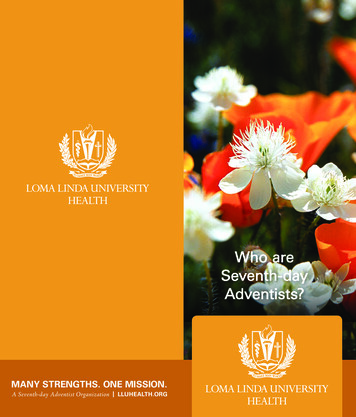
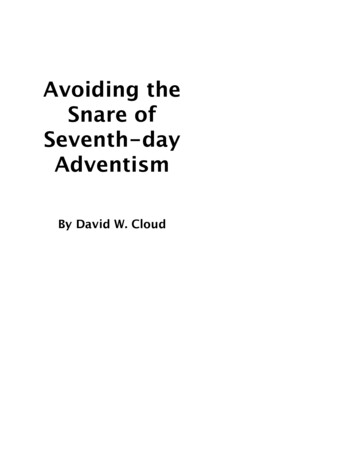
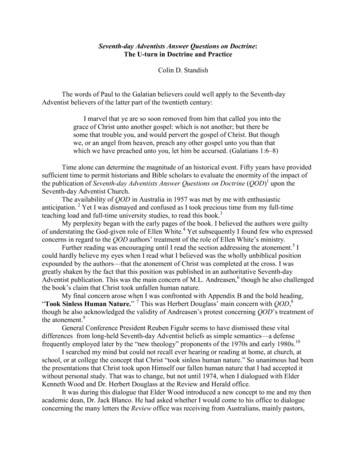
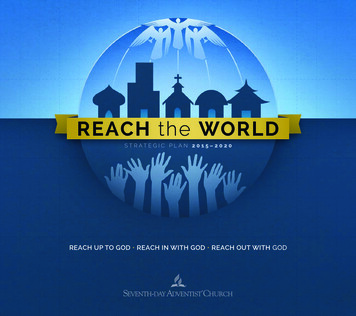
![Welcome [dashdiet.me]](/img/17/30-day-weight-loss-journal.jpg)
